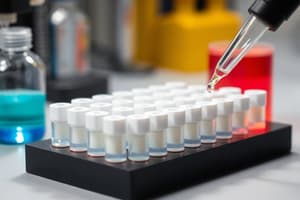Podcast
Questions and Answers
What is the primary mechanism behind capillary action in TLC?
What is the primary mechanism behind capillary action in TLC?
- Gravitational forces acting on the solvent
- Electrostatic attraction between the solvent and amino acids
- Adhesion between the solvent and the stationary phase
- Cohesion and surface tension of the solvent (correct)
What is the role of capillary action in TLC separation of amino acids?
What is the role of capillary action in TLC separation of amino acids?
- To selectively retain amino acids on the stationary phase
- To transport the solvent and amino acids up the TLC plate (correct)
- To facilitate diffusion of amino acids across the TLC plate
- To denature the amino acids for visualization
What is the result of capillary action on the TLC plate?
What is the result of capillary action on the TLC plate?
- Amino acids are separated based on their molecular weight
- Amino acids are separated based on their pKa values
- Amino acids are separated based on their interaction with the stationary phase (correct)
- Amino acids are separated based on their hydrophobicity
What is the effect of capillary action on the separation of amino acids?
What is the effect of capillary action on the separation of amino acids?
Why is capillary action important in TLC separation of amino acids?
Why is capillary action important in TLC separation of amino acids?
Flashcards are hidden until you start studying
Study Notes
Capillary Action in TLC
- Primary mechanism behind capillary action in TLC: surface tension and adsorption, where the solvent creeps up the thin layer of silica gel due to the attraction between the solvent molecules and the solid surface.
Role of Capillary Action in TLC Separation of Amino Acids
- Capillary action plays a crucial role in separating amino acids by carrying the solvent and the amino acids up the TLC plate, allowing them to interact with the stationary phase and separate based on their differing properties.
Result of Capillary Action on the TLC Plate
- As a result of capillary action, the solvent moves up the TLC plate, creating a uniform and controlled migration of the amino acids, allowing them to be separated and identified.
Effect of Capillary Action on the Separation of Amino Acids
- Capillary action enhances the separation of amino acids by allowing them to migrate at different rates, resulting in distinct and discrete bands on the TLC plate.
Importance of Capillary Action in TLC Separation of Amino Acids
- Capillary action is essential in TLC separation of amino acids as it enables the separation of these compounds based on their unique properties, allowing for accurate identification and analysis.
Studying That Suits You
Use AI to generate personalized quizzes and flashcards to suit your learning preferences.



